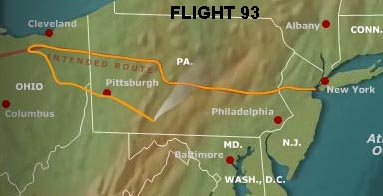
According to a nationwide poll conducted in May 2006 by Zogby International, 42 percent of the American people believe "there has been a cover-up" by the U.S. government and 9/11 Commission of critical evidence contradicting the official story of the September 11, 2001 terrorist attacks. 1 A good example of such contradictory evidence is found in the circumstances surrounding United Flight 93, a Boeing 757 that took off from Newark, New Jersey, for San Francisco at 8:42 a.m. with 7 crew members and 37 passengers, including 4 hijackers, and crashed in a field near Shanksville, Pennsylvania, at 10:03 (or 10:06 based on seismic evidence), as passengers were trying to wrest control of the plane from the hijackers. 2

STORY #1: "WE'RE JUST GOING TO HAVE TO ADJUST"
The first official story told by the military was that no jet fighters were scrambled before the Pentagon was hit at 9:38 a.m.. In other words, no fighters went up until the attacks were over (the last plane, Flight 93, never reaching a target). It is no wonder, given this first story, that many conspiracy theorists have argued that there was a military stand-down order on 9/11. No fighters ordered up is rather indistinguishable from a stand-down. And as David Ray Griffin has noted, there were good reasons to believe that this original story was true. Why would the military make up the most self-damning story possible? And those who told this story were certainly in positions to know what had happened, one being an official spokesman for NORAD and the other being the Vice Chairman of the Joint Chiefs of Staff. 4 (The Chairman, General Henry Shelton, was on a flight to Europe at the time of the attacks.)
NORAD's Marine Corps Major Mike Snyder, in an interview with the Boston Globe that was published on September 15, stated, in the Globe's words, that fighters "were not scrambled for more than an hour after the first hijacking was reported, by which time the three buildings were struck and a fourth hijacked plane was over Pennsylvania on a course toward Washington." Needless to say, Snyder had a tough time explaining this. He said that a hijacked airliner had never before been steered into a skyscraper. "This is an unprecedented event, unfortunately," Snyder said, "and we're just going to have to adjust accordingly." He said that it was only after the Pentagon was hit that the military realized the scope of the attack, and finally ordered fighters aloft. 5
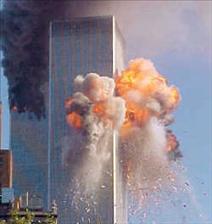
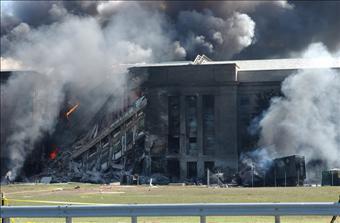
After denying that Flight 93 was shot down, General Myers testified, "When it became clear what the threat was, we did scramble fighter aircraft, AWACS, radar aircraft and tanker aircraft." But when Senator Carl Levin asked, "Was that order that you just described given before or after the Pentagon was struck? Do you know?", Myers left himself some wiggle-room by saying, "That order, to the best of my knowledge, was after the Pentagon was struck" (emphasis added). 6
Senator Bill Nelson, when his turn came, wasn't willing to leave it at that. "You said earlier in your testimony," Nelson said, "that we had not scrambled any military aircraft until after the Pentagon was hit. And so, my question would be: why?"
It is apparent from Myers's answer that he had conveniently brought no documents or notes with him that might shed some light on the subject. "I think I had that right, that it was not until then," Myers said. "I'd have to go back and review the exact timelines."
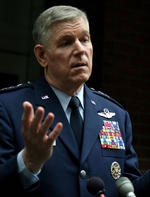
"You bet," Myers said. Nelson's pressure worked. Myers abruptly changed his story, his memory cleared up, right there on the spot. He said, "I spoke, after the second tower was hit, I spoke to the commander of NORAD, General (Ralph) Eberhart. And at that point, I think the decision was at that point to start launching aircraft."
Myers got away with this, even though he had testified only minutes before that on 9/11 he was meeting on Capitol Hill with Senator Max Cleland--one of the committee members, Cleland even remarked in the hearing how lucky they were that they had not been meeting in the Pentagon--when the Pentagon was hit. As Myers later stated in a Department of Defense interview, he knew nothing about the second World Trade Center tower being hit during his meeting with Cleland ("Nobody informed us of that"), the meeting ending just about the time that the Pentagon was struck, at 9:38. Myers stated in the DOD interview that it was after the Pentagon attack that he talked by phone with NORAD's Eberhart. 7
In any case, the government's story #1 about the military response (or lack thereof) on 9/11 died with Myers's about-face testimony at his confirmation hearing. But it didn't take long to replace it.
STORY #2: "FULL-BLOWER ALL THE WAY"
On September 14, the day after Myers switched gears, Dan Rather on the CBS Evening News reported that "contrary to early reports," jet fighters were scrambled and headed for both New York City and Washington during the attacks, but arrived too late to prevent them. The report included a timeline for the flights. 8.
When the Boston Globe article based on the interview of NORAD's Major Snyder was published the next day, it stated that Snyder had "no comment" on the CBS story, except to say that the fighters remained on the ground until the Pentagon was hit. 9 But on September 18, NORAD issued a news release that officially established the military's second story, nullifying Snyder's. It was a complete timeline of the military's response to the attacks. It looked impressive enough, if one didn't read it too closely.
According to the NORAD timeline, the Federal Aviation Administration (FAA) notified NEADS (the northeast sector of NORAD) of the hijacking of American Airlines Flight 11 at 8:40, and of United Flight 175 at 8:43. Two F-15s were scrambled at Otis Air National Guard Base in Massachusetts, and were airborne at 8:52. By then, Flight 11 had already crashed into the WTC north tower (8:46), and the F-15s were still 71 miles from New York City when United Flight 175 hit the south tower (9:03). 10
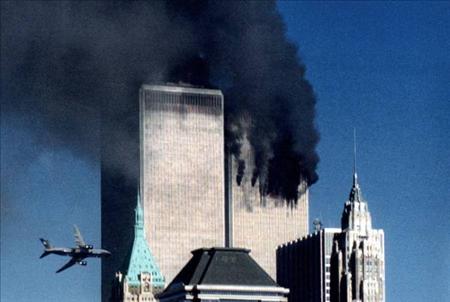
On United Flight 93, the timeline says that no hijack notification at all was received from the FAA. It doesn't indicate if NEADS was ever aware of this flight. The F-16s from Langley remained in place over Washington. But military officials subsequently let on that they were very much aware of Flight 93.
General Myers, at his September 13 confirmation hearing, said only (again in his inimitable noteless fashion), "My memory says that we had launched on the one that eventually crashed in Pennsylvania. I mean, we had gotten somebody close to it, as I recall. I'll have to check that out." 11 Apparently someone did so, as on September 15 Deputy Secretary of Defense Paul Wolfowitz stated, "The Air Force was tracking the hijacked plane that crashed in Pennsylvania . . . and had been in a position to bring it down if necessary." 12 This would seem to confirm a CBS report aired before the crash that two F-16s were tailing Flight 93, as well as the reported statement of an air traffic controller that "an F-16 fighter closely pursued Flight 93." 13 (Wolfowitz, after watching the second plane hit the WTC on TV, continued conducting a routine meeting in his Pentagon office, since, in his words, there "didn't seem to be much to do about it immediately.") 14
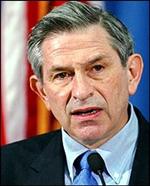
Arnold testified that "very shortly (after the Otis fighters were scrambled) we got a call" on Flight 93 "being a possible hijacking. . . . That aircraft wandered around and flew up over the northern part of Pennsylvania and Ohio." At one point "we thought either (Delta Flight 1989, not hijacked) or the United 93 might pose a threat to Detroit. We tried to get airplanes airborne out of the Toledo National Guard at that particular time. Can you get anything airborne? Because we have this United 93 and this Delta. We need to intercept it and see what is going on with those particular aircraft." 16
Arnold testified, "We launched the aircraft out of Langley to put them over the top of Washington, D.C., not in response to American Airline 77, but really to put them in position in case United 93 were to head that way." When asked if the F-16s could have intercepted Flight 93 had it not crashed, Arnold said:
It was our intent to intercept United Flight 93. And in fact my own staff, we were orbiting now over Washington, D.C. by this time, and I was personally anxious to see what 93 was going to do, and our intent was to intercept it. But we decided to stay over Washington, D.C., because there was not that urgency . . . until that aircraft was definitely coming towards us. And, as you know, the brave men and women who took over that aircraft prevented us from making the awful decision which the young men that were flying those aircraft would have lived with for the rest of their lives if they had to do that.

General Winfield told ABC News on September 11, 2002, "We received the report from the FAA that Flight 93 had turned off its transponder, had turned, and was now heading towards Washington, DC." Winfield said that a "decision was made to try to go intercept Flight 93," after the president had given permission to shoot it down. "We started receiving reports from the fighters that were heading to intercept," Winfield said. "The FAA kept us informed with their time estimates as the aircraft got closer and closer." 17
Were these F-16s armed, sent from the skies over Washington? Apparently not, as Colonel Marr told the same ABC News program that the closest fighters were "two F-16 pilots on a training mission from Selfridge Air National Guard Base near Detroit." And what were these pilots, with no real munitions, to do upon reaching Flight 93? Marr said, "We're gonna put them as close to that airplane (as) they can get, in view of the cockpit, and convince that guy in that airplane that he needs to land." 18
Neither Winfield nor Marr seemed to know exactly what happened as the F-16s closed on Flight 93. "The closure time came and went, and nothing had happened," Winfield said. "We had basically lost situational awareness of where this airplane was. . . . It was about, you know, 10:03 that the fighters reported that Flight 93 had crashed" 19.
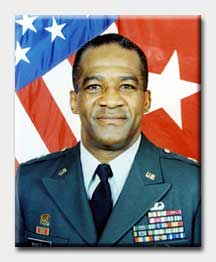
The biggest problem for the military, however, came after the 9/11 Commission forced the military, by subpoena, to hand over hours of NORAD tapes from the day of the attacks. The tale of the tapes was found to be at striking variance from the tale (story #2) that had been told by the military to the Commission and to the public. 23 "We to this day don't know why NORAD told us what they told us," 9/11 Commission chairman Thomas H. Kean would later say. "It was just so far from the truth." John Farmer, Jr. the Commission's senior counsel, said, "I've been in government and I know what spin is." Story #2 was "a whole different order of magnitude than spin. It simply wasn't true." 24
The military, with no other choice, decided that it was time for another story. One that would at least be consistent with the truth revealed in the tapes.
STORY #3: WHERE'S THE FAA WHEN YOU NEED IT?
The intent of story #3, making the best of a bad situation, is to exonerate the military as much as possible for shortcomings on 9/11 and blame the FAA for not giving NORAD enough timely information to do its job. This story, thanks to the subpoened tapes, was introduced in the Commission's Staff Statement No. 17 and final public hearing in June, 2004, and incorporated in The 9/11 Commission Report as the final say. But was the military's story #3 successful in its intent? Three strikes, after all, and you're out.
What was the standard operating procedure in the event of a hijacking? The National Military Command Center (NMCC) was to be "notified by the most expeditious means by the FAA." The NMCC would then forward the request for military assistance to the Secretary of Defense for approval, but exceptions were allowed for "immediate responses." 25 On 9/11, FAA's Boston Center concluded at 8:25 a.m. that AA Flight 11 had been hijacked. FAA headquarters learned of the hijacking at 8:32, yet it was Boston Center that took it upon itself, bypassing the chain of command, to contact the military at 8:38. (Boston contacted not the NMCC but NEADS.) 26 To this point the FAA had clearly not acted expeditiously. But the military still had 9 minutes before Flight 11 would strike the WTC north tower.
Colonel Marr, at NEADS in Rome, New York, ordered the two Otis fighters on alert to battle stations, but then called General Arnold, NORAD continental commander at Tyndall AFB in Florida, for permission to launch the fighters. Arnold said to go ahead and scramble and they would get approval later. The F-15s were scrambled at 8:46, which is also the time that Flight 11 crashed into the WTC north tower. The fighters were airborne at 8:53. "In summary," the Commission report says, NEADS received only 9 minutes notice of the hijacking from the FAA before Flight 11 hit the tower. 27 While the FAA certainly could have called sooner, the Commission fails to note that 8 of those precious 9 minutes were inexplicably used up by the phone call from Colonel Marr to General Arnold. Given that the "immediate responses" option was available, the military like the FAA did not start that day too expeditiously. (Since the secure-line phone conversation between Marr and Arnold was not recorded, unlike the conversations on the operations floor at NEADS, the NORAD tapes do not tell us why this call consumed 8 minutes.) 28
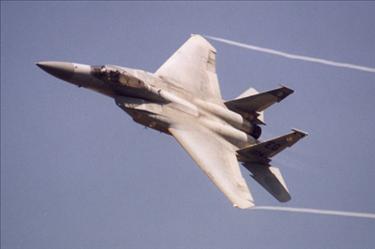
We are told that F-16s were scrambled at Langley and in the air at 9:30. But this was not in pursuit of hijacked AA Flight 77 (which NEADS "by chance" learned was "missing" at 9:34 during a call to the FAA's Washington Center) 31, nor of United Flight 93 as earlier claimed by Arnold, but in vain pursuit of a phantom AA Flight 11. Allegedly someone at FAA headquarters (the Commission was "unable to identify the source of this mistaken FAA information") had reported that Flight 11 was still in the air and was headed toward Washington. 32 After takeoff, by the way, the Langley pilots proceeded to fly east over the ocean, instead of north (to try to head off phantom Flight 11 in the Baltimore area), until ordered to turn around, thus adding some 50 miles (or 100 miles round trip) to their destination (a Keystone Kops performance that was hardly the fault of the FAA). 33
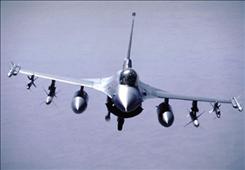
But if the military told some tall tales, the FAA told at least one of its own. The FAA issued this statement in May 2003, read into the record of the 9/11 hearings:
Within minutes after the first aircraft hit the World Trade Center, the FAA immediately established several phone bridges that included FAA field facilities, the FAA command center, FAA headquarters, DOD, the Secret Service and other government agencies. The U.S. Air Force liaison to the FAA immediately joined the FAA headquarters phone bridge and established contact with NORAD on a separate line (emphasis added). The FAA shared real-time information on the phone bridges about the unfolding events, including information about loss of communication with aircraft, loss of transponder signals, unauthorized changes in course, and other actions being taken by all the flights of interest. 35
The 9/11 Commission later found that contrary to this FAA statement, the Air Force liaison did not join the FAA phone bridge until after Flight 77 hit the Pentagon at 9:37 a.m. 36 With this and the military's tales, the Commission, behind closed doors in 2004, considered referring to the Justice Department for criminal investigation the question of whether military and FAA witnesses had lied to the Commission. It was decided to refer the matter instead to the inspectors general for the Departments of Defense and Transportation. 37 In August 2006, a Pentagon spokesman said that the DOD inspector general's probe found mistakes and had corrected the record but found "nothing in the course of their review that indicates testimony by DOD was knowingly false" 38 A month later the FAA's acting inspector general released his report, stating, "We did not find evidence that FAA officials knowingly made false statements." The report did urge the FAA to consider disciplinary action against executives who failed to correct the false information after it had been provided. 39
As for The 9/11 Commission Report, it simply states that "inaccurate government accounts" (story #2) "overstated the FAA's ability to provide the military with timely and useful information that morning." 40 The Commission report diplomatically says that the "true picture" of events does not reflect "discredit" on personnel of either NEADS or the FAA. 41 But with the report's portrayal of FAA confusion, late notifications to the military on Flights 11 and 175, and no notifications at all on Flights 77 and 93, it is clear who is taking the fall. The FAA came out of the 9/11 Commission hearings with a big black eye, due to what Republican Commissioner John F. Lehman (former Secretary of the Navy under Reagan) called the "fairly gross shortcomings in the management of the headquarters of FAA." As Democratic Commissioner Bob Kerrey (a former senator from Nebraska) more succinctly put it, "I think (FAA) headquarters blew it." 42 To make the military look noble as the FAA's innocent victim, Kerrey told General Eberhart in the final hearing, "I've got some concern for the military in this whole situation," because "you all are taking a bullet for the FAA," since "the FAA should have told you what was going on." 43
"I, for one," Eberhart replied, "do not get into FAA-bashing."
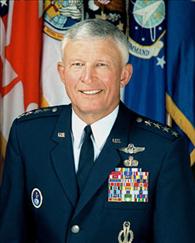
Eberhart's generously self-serving statement did not take into account the question of whether authorization to shoot down any aircraft could have been obtained in time from the President. I won't go into the priority famously placed by Bush on finishing a pet-goat story ("to project strength and calm until he could better understand what was happening"), but authorization for any shootdown was not confirmed until 10:18, and was not communicated to NEADS until 13 minutes later. 45 With that authority (and all the hijacked aircraft already crashed), General Arnold said: "We created a free-fire zone over the nation's capital." 46 The trouble is, nobody told the pilots. Colonel Marr, the NEADS commander, did not pass along the order to the pilots to shoot down unresponsive hijacked aircraft because, as he put it, he was "unaware of its ramifications." 47 This prompted Commission chairman Kean to say, "When the President of the United States gives a shoot-down order, and the pilots who are supposed to carry it out do not get that order, then that's about as serious as it gets as far as the defense of this country goes." 48
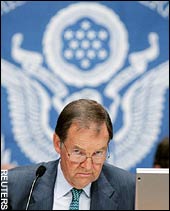
To counter these FAA statements, the military alleged that problems with communications equipment, implicitly the fault of the FAA, prevented the military from getting real-time information from the FAA. Navy Captain Charles J. Leidig, Jr., who was the inexperienced watch commander at the NMCC during the attacks (his superior General Winfield had arranged the night before to take time off beginning at 8:30 a.m. on 9/11, and returned to duty when the attacks were over) convened a "significant event conference" (upgraded at 9:37 to an "air threat conference") in which he said there were some equipment "compatibility problems" in communicating with the FAA. 50 The 9/11 Commission Report says that when the NMCC conference call, which began at 9:29, asked the FAA for an update, "the line was silent because the FAA had not been added to the call. . . . Operators worked feverishly to include the FAA, but they had equipment problems and difficulty finding secure phone numbers." 51
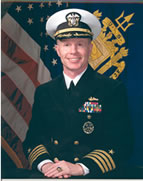
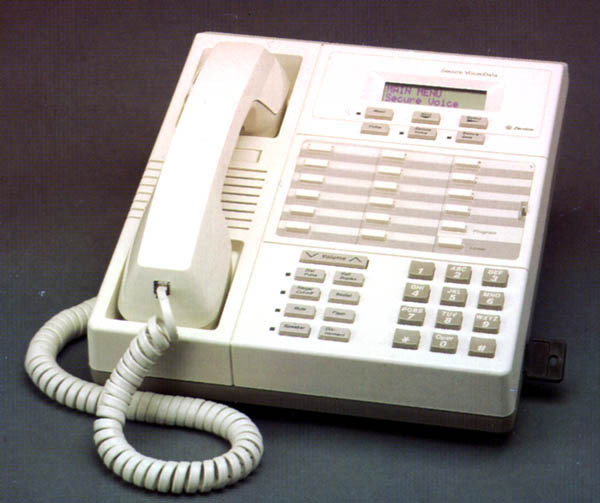
Benedict Sliney, who was the Operations Manager at FAA's Command Center in Herndon, Virginia (9/11 was Sliney's first day on the job), referred in his testimony to the Command Center's "military cell, which was our liaison with the military services." 57 "If you tell the military," Sliney testified, "you've told the military. . . . (E)veryone who needed to be notified about the events transpiring was notified, including the military." (Sliney also said of the military, "I suppose it's too simplistic to say that they all look alike to me.") 58
It should also be noted that the Secret Service had an open line with the FAA, and had a radar system that allowed it to see what the FAA's radar was seeing. 59
As for the President, we are told that Bush, once aboard Air Force One, had trouble communicating with the Vice President and others at the White House because the line "kept cutting off." More telephone problems! We are not told why this trouble occurred on Air Force One, on 9/11 of all days, but only that Bush was "frustrated." 60
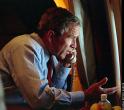
There is one person who could possibly shed a great deal of light on what really went on between the military and FAA on 9/11. This person occupied the FAA hot seat on 9/11, chairing the hijack teleconference. Incredibly, this person's name is a government secret, as is whatever he or she knows about 9/11. Why should that be?
FAA protocol in the event of a possible hijacking specifically called for "the hijack coordinator on duty to contact the (NMCC) and ask for a military escort to follow the flight." In his testimony, Belger defined the hijack net previously referred to as "an open communication run by the FAA hijack coordinator." 61
Who was the hijack coordinator? The job officially belonged to the FAA's Director of Civil Aviation Security or his or her designate. 62 On 9/11 the director, Major General Michael A. Canavan, was in San Juan, Puerto Rico. 63 So who was his designate? Who ran the FAA's 9/11 "hijack net"? Publicly, for reasons unknown, no one knows.
One of the most remarkable moments in the 9/11 hearings occurred during the beleaguered Belger's testimony. Republican Commissioner Slade Gorton stated that "when asked to identify who the hijack coordinator was on 9/11, it was difficult to find two witnesses (at the FAA) who identified the same individual." 64 Well, who was it? One would think at that point that some ears might have perked up among the otherwise slumbering media. It seems natural that Gorton would add, or Belger would volunteer, or some journalist after the hearing would ask, or somewhere in its report the Commission would state, who the hijack coordinator was. But the person's identity, even after Gorton referred to the mystery in an open hearing, is absent from the public record.
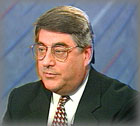
We don't even know if the 9/11 Commission interviewed the hijack coordinator, or this "security person." Did this person who ran the hijack net really have nothing of significance to contribute to our understanding of what happened that day? Then why aren't we told that?
It is conceivable, of course, that there was no hijack coordinator on 9/11, that Canavan had failed to designate anyone. But if so, why didn't someone ask Canavan why when he testified before the Commission? What better way to further blame the FAA for 9/11 than to point out Canavan's negligence? But during Canavan's testimony the term "hijack coordinator" was not even mentioned. It seemed to be studiously avoided. 65
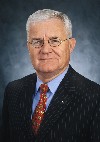
From the moment that Gorton made his comment, through the end of the hearings, the unidentified 9/11 hijack coordinator was the elephant in the hearing room.
There is another animal metaphor that seems equally appropriate: The hijack coordinator question appears to be a case of "let sleeping dogs lie." For the benefit of whom? The FAA, or the military?
WAS FLIGHT 93 SHOT DOWN?
If the military, in accordance with story #3, did not even know about Flight 93 till it crashed, then of course the military did not shoot it down, and had no aircraft tracking it. Yet the government itself has let slip that Flight 93 was being tracked by an aircraft, and has in its possession a cockpit voice recording from that aircraft containing significant but still secret information. And several witnesses in the Flight 93 crash-site area did see a "small white jet" flying low both before and after the crash, circling the crash site and then zooming away.
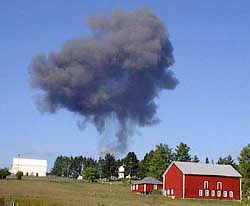
The best description came from Susan Mcelwain, who lived two miles from the crash site. "(The small jet) came right over me. . . . (It) was heading right to the point where Flight 93 crashed and must have been there at the very moment it came down." Mcelwain initially thought that it was the small white jet that crashed, and called 911. "It was white with no markings," she said, "but it was definitely military, it just had that look. It had two rear engines, a big fin on the back like a spoiler on the back of a car and with two upright fins at the side. I haven't found one like it on the Internet. It definitely wasn't one of those executive jets." 70
McElwain said, "The FBI came and talked to me, and said there was no plane around. Then they changed their story and tried to say it was a plane taking pictures of the crash 3,000 ft. up. But I saw it and it was there before the crash and it was 40 ft. above my head. They did not want my story--nobody here did." 71
An official at the Cleveland Air Traffic Control Center, when asked if there was a record of a second plane over the crash site, said, "That's something that the FBI is working on and I cannot talk about that." 72
On September 16 the Pittsburgh Post-Gazette published a story that the FBI claimed cleared up the mystery. According to FBI agent William Crowley, a Fairchild Falcon 20 business jet, owned by the Greensboro, North Carolina, apparel maker VF Corp. and piloted by Yates Caldwell, had been "directed to the crash site" to get its coordinates for rescuers. This, said Crowley, "explains" the "white or silver jet" that people said "flew by moments after the crash." 73
Besides getting the name of the plane wrong (the Falcon 20 was built by the French company Dassault, not Fairchild), 74 the problem with the FBI's story is that the small white jet was seen before the crash, not just after it. This story was nonetheless repeated in the March 2005 issue of Popular Mechanics (in an article entitled "9/11: Debunking the Myths"), which at least got the name of the plane right (Dassault Falcon 20), if not the name of the pilot ("Yates Gladwell"). 75
Based on the government's own account, the Falcon 20 was not tracking Flight 93 before it crashed, because the Falcon was allegedly diverted, while on its way to land at the Johnstown airport, in order to help find the crash site, not to track or help find a 757 still in the air. Furthermore, there was no mystery about the crash site, as local fire and rescue were there within minutes. 76 Many witnesses had heard the explosion and saw the mushroom cloud. Several drove to the site themselves, while others could point all interested parties toward the tell-tale cloud of smoke. And if aerial assistance was nonetheless needed, why did the "small white jet" simply fly away? Finally, the black smoke from the crash site was seen and reported, less than two minutes after the crash, from several miles away by a C-130 military cargo plane on its way to Minnesota. Could this military aircraft not be diverted if needed? Incidentally, for those who like coincidences (and the official 9/11 story is full of them), this was the same C-130 that only half an hour before had "witnessed" Flight 77 crash into the Pentagon. 77
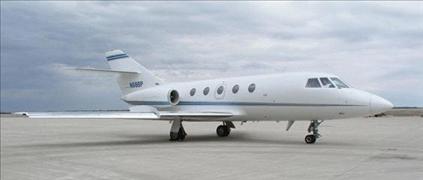
The Associated Press contacted NetJets, and reported the following: "An official for NetJets . . . confirmed that the plane tracking Flight 93 belonged to the company. The official, who asked not to be identified by name, said the company was asked not to comment on the Sept. 11 flight but would not say who made the request." 79
What is NetJets? It is an executive-jet fleet that is partly owned by Warren Buffett, an American billionaire who is a 9/11 story himself. On the morning of the attacks, Buffett (who is known as the Oracle of Omaha) was hosting a charity golf event in Omaha, Nebraska, specifically at Offutt Air Force Base, the same base to which President Bush would fly later that day during his 9/11 wanderings. One of Buffett's guests at the charity event was Anne Tatlock, chairman and CEO of Fiduciary Trust Co. International, whose offices were spread among the 92nd to 97th floors of the World Trade Center's south tower. Tatlock arrived at Offutt in time to see United Flight 175 hit the south tower on TV: "I watched the second plane crash into my office." (87 of Fiduciary's 650 employees died in the attack.) 80
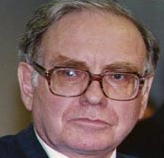
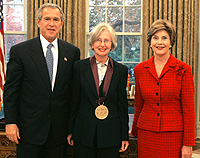
This doesn't mean that NetJets offers only one model of aircraft. The fleet is composed of executive jets from various manufacturers. These include the improved Dassault Falcon 2000EX. 82
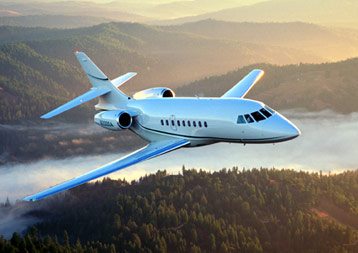
Did it in fact exist? Was the small white jet something else? A NetJet or any other civilian aircraft diverted to track Flight 93 would not be doing so at a perilously low altitude, like some 40 feet above Susan Mcelwain's head. However, an unmarked military aircraft on a mission would be a different story. Take the A-10 Thunderbolt II, for example. Called the Warthog, it has rear-mounted engines and two tail fins like Mcelwain described. 83 (The F-15 also has two tail fins.) Also, as previously noted, there was a CBS report before the crash about two F-16s tailing Flight 93, and an air traffic controller's statement that an F-16 closely pursued Flight 93. 84 And when one of the Otis fighter pilots, Major Daniel (Nasty) Nash, returned to base on 9/11, he was told by a crew member on the ground that an F-16 had shot down an airliner in Pennsylvania--"a report that turned out to be incorrect." 85
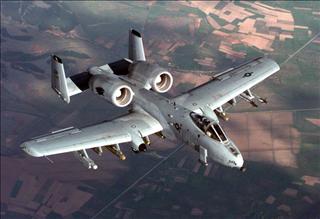
Secretary of Defense Donald Rumsfeld, talking to the troops in Iraq on Christmas Eve of 2004, talked about "the people who did the bombing in Spain, or the people who attacked the United States in New York, shot down the plane over Pennsylvania and attacked the Pentagon" (emphasis added). 86 A slip of the tongue? No doubt. But does the secretary's faux pas tell us something?
There were several eyewitnesses in the area when Flight 93 descended erratically from the sky in Pennsylvania. Some said it flew upside down before crashing, and unusual engine noise was reported. But only a few reported one or more explosions or bangs, and none reported smoke, before the plane crashed. 87 Also, no witnesses reported explicitly seeing a jet fighter in the area, though two (Mcelwain and Brant) did describe the small white jet as looking like a military aircraft or fighter. 88
The Flight 93 cockpit voice recording was played for relatives in April 2002, and for the jury in the Moussaoui trial 4 years later, but only a transcript has been released to the public (with the excuse that if the tape were publicly released it would be "played repeatedly on newscasts"). 89 The AP reported that the tape included "static noises, cockpit alarms and wind." 90 CNN reported relatives as saying the recording "was muffled specially by the noisy rush of air." 91 The Philadelphia Daily News quoted relatives as hearing on the tape a final "rushing sound" at 10:03. 92 Also, Lorne Lyles, husband of flight attendant CeeCee Lyles, heard "a whooshing sound, a sound like wind" during the cell phone call he received from his wife. 93
These reports suggest that the plane had been holed by a missile or bomb--the hijackers claimed to have a bomb on board 94--and debris on the ground more than 8 miles away from the impact crater is certainly indicative of structural damage or the plane breaking up in the air, with decompression sucking things out of the plane. The government concluded that no explosive was involved in the crash, and "Nothing was found that was inconsistent with the plane going into the ground intact." 95 It has made no comment on the sound of wind of the aircraft's CVR.
Part of an engine fan weighing about 1,000 pounds was found far enough away from the impact crater to suggest it may have been the target of a heat-seeking missile, rather than having been propelled that far by the crash. 96 Clothing, books, and what appeared to be human remains could not have been blown miles away by the crash or by wind (about 10 mph), and it's questionable whether paper items like checks and financial statements (the plane had a cargo of mail) traveled over a mountain ridge 8 miles from the crash site that day, to be found lying in someone's yard. 97 John Fleegle, service manager at the Indian Lake Marina a mile and a half from the crater, said he gave FBI agents a boat tour of the lake after what appeared to be bone and flesh washed up at the marina. They collected almost a garbage bag full of debris from the lake. 98
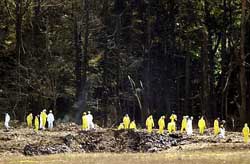
The FBI confiscated the tape, and Cramer was reportedly told not to discuss the call. 100 Moreover, in its series of articles on the crash, often repeating previously reported information including Felt's phone call, the Pittsburgh Post-Gazette conspicuously left out, without explanation, its originally reported references to an explosion and smoke. John Shaw, who was eventually identified as the dispatcher who had directly taken Felt's call, and who was locally honored for the professional way he handled it, denied that Felt mentioned an explosion or smoke: "Didn't happen." 101 Felt's sister Sandra, after hearing a copy of the tape, said it contained no reference to an explosion or smoke. 102 Also, one of the few witnesses on the ground who reported hearing explosions before the crash changed her story, if two separate news sources are to be believed. Linda Shepley, according to ABC News, told Pittsburgh TV station KDKA that "she heard a loud bang and saw the plane bank to the side before crashing." 103 A month later, the Philadelphia Daily News reported Shepley as saying that rumors of a shootdown were "not true." She said that she had an unobstructed view and the plane went down intact--"there was nothing wrong with it." 104 And the American Free Press in 2005 reported asking witness Tom Spinelli--who soon after the crash had described the small white jet flying around--about what he saw. "Sorry, no comment," Spinelli is quoted as saying. "That's all I can say." 105
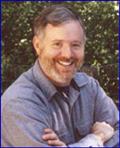
 Edward P. Felt | John Shaw
Edward P. Felt | John Shaw
The 9/11 Commission Report, in stating that the plane crashed at 10:03 (based on various "data sets," about which we must take its word), claims in a footnote that the seismic data is "too speculative," and that one of the authors of the study "now concedes" (in an email to the Commission) that 'seismic data is not definitive for the impact of UA 93.'" 108
Since the public has no access to this email, we cannot read it for context, nor do we know the wording of the question that occasioned it. But the quoted portion could simply be saying the same thing that any scientist will tell you: there is no certainty in science. Tomorrow will the Earth still be orbiting the sun? We don't know--it is not "definitive"--but based on all of our science, it is highly probable.
CONCLUSION
I will conclude where I began, with the Zogby International nationwide poll of May 2006. 45 percent of Americans believe that "so many unanswered questions about 9/11 remain that Congress or an International Tribunal should re-investigate the attacks, including whether any U.S. government officials consciously allowed or helped facilitate their success." 109
I can't argue with that. And I hope that if nothing else this article has helped establish at least three simple questions that any new investigation should ask early on.
Who was the FAA hijack coordinator on 9/11? (If no designate had been appointed, then who chaired the 9/11 hijack net?)
Who was flying the small white jet, tracking United Flight 93?
Why have we the people not been entitled to know the answers, so carefully guarded, to the first two questions?
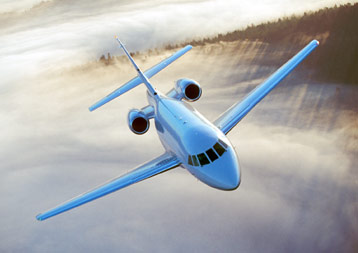
Footnotes:
1. Rebecca Wittman, "RE: Results from Nationwide Poll," Zogby International, May 17, 2006. According to a poll conducted by the New York Times and CBS News in October 2006, 53 percent of adult Americans think the Bush administration is hiding something about 9/11, 28 percent think they are mostly lying, and only 16 percent think they are telling the truth ("Americans Question Bush on 9/11 Intelligence," Angus Reid Global Monitor, October 14, 2006).
2. The 9/11 Commission Report, pp. 10-14. The four hijacked flights were scheduled to take off between 7:45 and 8:10 that morning, but Flight 93 was delayed and did not take off until 8:42 due to heavy morning traffic at the Newark airport (Report, p. 10).
3. "Investigators Locate 'Black Box' from Flight 93," Pittsburgh Post-Gazette, 9/13/01; Jonathan D. Silver, "NORAD Denies Military Shot Down Flight 93," Pittsburgh Post-Gazette, 9/14/01; Richard B. Myers, Testimony, Senate Confirmation Hearing, 9/13/01.
4. David Ray Griffin, The 9/11 Commission Report: Omissions and Distortions (Northampton, MA: Olive Branch Press, 2005), p. 143.
5. Glen Johnson, "Facing Terror Attack's Aftermath," Boston Globe, 9/15/01.
7. Ibid. Myers then changed his story (and Cleland's) again before the 9/11 Commission on June 17, 2004, testifying that he had already left Capitol Hill when he got the call from Eberhart saying "We've had these crashes and that we're going to take certain actions," and that the Pentagon was hit shortly thereafter "as we were on our way back to the Pentagon" (Panel II, 9/11 Commission 12th Public Hearing, 6/17/04).
8. Griffin, p. 142.
9. Johnson.
10. NORAD News Release, "NORAD's Response Times," September 18, 2001.
11. Myers confirmation testimony.
12. Boston Herald, 9/15/01, quoted in George Szamuely, "The Bunker," New York Press, 12/11/01, and Griffin, p. 150.
13. CBS News, 9/11/01; AP 9/13/01; Nashua (NH) Telegraph, 9/13/01; quoted in Griffin, p. 150.
14. Vanity Fair interview, May 9, 2003.
15. Colonel Alan Scott, Panel I, 9/11 Commission 2nd Public Hearing, May 23, 2003;Report, pp. 33, 34.
16. Major General Larry Arnold (Ret.), Panel I, 9/11 Commission 2nd Public Hearing, May 23, 2004.
17. "9/11: Interviews by Peter Jennings," ABC News, 9/11/02.
18. Ibid.
19. Ibid.
20. Mark Elsis, "NORAD 911 Stand Down Math," accessed 6/5/06; Karen de Vries, "Scrambled F15's From Otis Air Force Base: Mach 1.5 or Cruise Speed?," Prison Planet, 10/21/04.
21. William B. Scott, "Exercise Jump-Starts Response to Attacks," Aviation Week & Space Technology, 6/3/02; Arnold testimony.
22. Elsis.
23. Michael Bronner, "9/11 Live: The NORAD Tapes," Vanity Fair, August 1, 2006.
24. Dan Eggen, "9/11 Panel Suspected Deception by Pentagon," New York Times, August 2, 2006.
25. Chairman of Joint Chiefs of Staff, "Aircraft Piracy (Hijacking) and Destruction of Derelict Airborne Objects," 6/1/01, quoted in Griffin, p. 165.
26. Report, pp. 19-20.
27. Report, pp. 20-21.
28. Bronner.
29. Report, p. 23.
30. Bronner. The Report states incorrectly that the F-15s were directed into a holding pattern off Long Island before Flight 175 hit the south tower (p. 20). It is unclear from the complicated footnote (p. 459) how this conclusion was reached in spite of Nasypany's taped objection to diverting the fighters after the second tower was struck, as well as the 2002 statement of one of the F-15 pilots, Major Daniel Nash (Kevin Dennehy, "I Thought It Was the Start of World War III," Cape Code Times, 8/21/02).
31. Report, p. 27.
32. Report, p. 26.
33. Report, p. 27. The phantom Flight 11 story first surfaced during story #2, but was not factored into the military's official account until story #3. Lt. Col. Dawne Deskins of the Air National Guard told ABC News in 2002, "(The FAA) told us that they showed the American Airlines Flight 11 was still airborne. So now, we're looking at this, well if, if an aircraft hit the World Trade Center, who was that?" ("9/11: Interviews by Peter Jennings," ABC News, 9/11/02). In the final 9/11 Commission hearing in May 2004, Commissioner Richard BenVeniste asked General Arnold why the Commission was not told during Arnold's previous appearance in May 2003 that a phantom Flight 11, and not Flight 77 or 93, was the reason (per story #3) that the Langley fighters were scrambled, as "this skewed the whole reporting of 9/11." Arnold's tortuous answer was that he did not know "the call signs of the airplanes when these things happened," that the call about Flight 11 simply led him to conclude that "there were other aircraft in the system that were a threat to the United States," and that during his first appearance, "I was trying to remember in my own mind what was it that persuaded us to scramble those aircraft. And I thought at the time it was United 93" (Panel II).
34. Larry Arnold, Testimony, Panel II, 9/11 Commission 12th Public Hearing, June 17, 2004. See note 41 below. Former U.S. government counterterrorism czar Richard A. Clarke also participated in the now officially false story of the military's pursuit of United Flight 93 in his book Against All Enemies (New York: Free Press, 2004). Clarke has Vice Chairman Meyers reporting in a White House teleconference chaired by Clarke on 9/11, "We have fighters from the Michigan Air National Guard (referring to the two unarmed Selfridge fighters) moving east toward a potential hostile over Pennsylvania" (p. 12). Later, Clarke writes of being told "what had happened to one of the aircraft we thought was headed toward us (emphasis added). 'United 93 is down, crashed outside of Pittsburgh'" (p. 15). (For more on Clarke's book, see "Who Was Where on 9/11?.")
35. Federal Aviation Administration, "FAA Communications with NORAD on September 11th, 2001," Panel 1, 9/11 Commission Public Hearing, May 23, 2003.
36. "Report: FAA Didn't Intentionally Mislead 9/11 Commission," Associated Press, September 1, 2006; Philip Shenon, "Report Urges FAA to Act Regarding False 9/11 Testimony," New York Times, September 2, 2006.
37. Bronner; Eggen, "9/11 Panel."
38. "9/11 Panel Distrusted Pentagon Testimony," CNN, August 2, 2006.
39. "Report: FAA Didn't Intentionally Mislead 9/11 Commission"; Shenon.
40. Report, p. 34.
41. Report, p. 31.
42. Panel III, 9/11 Commission 12th Public Hearing, 6/17/04.
44. Ralph E. Eberhart, Testimony, Panel II, 9/11 Commission 12th Public Hearing, June 17, 2004.
45. Report, pp. 38, 41, 45.
46. Scott.
47. Report, p. 43.
48. Dan Eggen, "9/11 Report Cites Lack of Preparation," Washington Post, 6/18/04.
49. Monte Belger, Testimony, Panel III, 9/11 Commission 12th Public Hearing, June 17, 2004.
50. Charles J. Leidig, Jr., Testimony, Panel II, 9/11 Commission 12th Public Hearing, June 17, 2004. On Winfield's absence from the NMCC, see Ecker, note 14.
51. Report, p. 37.
52. See Secure Telephone Units and Wikipedia's STU-III. The 9/11 Commission Report also states that when a FAA representative finally joined the NMCC conference call at 10:17, when of course the attacks were over, the person, whoever he or she was, had no useful knowledge or information (Report, p. 37).
54. Monte Belger, Prepared Statement, 9/11 Commission, 12th Public Hearing, June 17, 2004.
55. Report, p. 30.
56. Jeff Griffith, Written Statement, 9/11 Commission, June 9, 2004.
57. Benedict Sliney, Testimony, Panel III, 6/17/04.
58. Ibid.
59. Richard A. Clarke, Against All Enemies (New York: Free Press, 2004), p. 7.
60. Report, p. 40.
61. Report, pp. 17-18; Panel III, 6/17/04.
62. Report, p. 17.
63. Major General Mike Canavan, Testimony, Panel I, 9/11 Commission 2nd Public Hearing, May 23, 2003.
66. The Bergen Record, 9/14/01.
67. Jeff Pillets, "In Rural Hamlet, the Mystery Mounts," The Bergen Record, 9/14/01; "Was United Flight 93 Shot Down on Sept. 11?", WorldNetDaily (WND), 1/25/03.
68. Jere Longman and Jo Thomas, "Recovered Recorder May Give Clues of a Struggle for Control," New York Times, 9/14/01.
69. Richard Wallace, "What Did Happen to Flight 93?", London Mirror, 9/12/02.
70. WND, 1/25/03.
71. Ibid.
72. Pillets.
73. Bill Heltzel and Tom Gibb, "2 Planes Had No Part in Crash of Flight 93," Pittsburgh Post-Gazette, 9/16/01.
74. Dassault Falcon 20, Smithsonian National Air and Space Museum.
75. "9/11: Debunking the Myths," Popular Mechanics, March 2005.
76. James Sanders, "The Downing of UA Flight 93," WND 4/26/04.
77. Report, p. 30.
78. Larry Margasak, "(Government Says It Wants to Show Photos and Video," Associated Press, 8/9/02.
79. Ibid.
80. Ron Leuty, "Franklin Unit Rebuilds after 9/11 Tragedy," San Francisco Times, 2/4/02.
81. Robert L. Miles,"Buffett Air," Flying, May 2002.
82. NetJets Dassault Falcon 2000EX Photo Gallery.
83. See A-10, Fairchild (Warthog) and A-10/OA-10 Thunderbolt II.
84. CBS News, 9/11/01; AP 9/13/01; Nashua (NH) Telegraph, 9/13/01; quoted in Griffin, p. 150.
85. Kevin Dennehy, "I Thought It Was the Start of World War III," Cape Code Times, 8/21/02. Susan Mcelwain, the witness who gave the best description of the small white jet in the crash area, had an additional story to tell, according to the London Mirror. She said that within hours of the crash, a friend whose husband was in the Air Force called her, the friend told Mcelwain, and said, "I can't talk, but we�ve just shot a plane down" (Richard Wallace, "What Did Happen to Flight 93?," London Mirror, 9/12/02).
86. "Surprise Visit for Donald Rumsfeld," CNN, 12/24/04.
87. Longman and Thomas; John Carlin, "Unanswered Questions: The Mystery of Flight 93," The Independent, 8/13/02.
88. Wallace; WND, 1/25/03.
89. "Judge Seals Flight 93 Cockpit Tapes," New York Daily News, 4/11/06.
90. Ted Bridis, "Feds: Hijackers Crashed Flt. 93 on 9/11," Associated Press, 8/8/03.
91. "Families Say Flight 93 Tapes Prove Heroism," CNN, 4/19/02.
92. William Bunch, "Cockpit Voice Recording Ends before Flight 93's Official Time of Impact," Philadelphia Daily News, 9/16/02.
93. Paul Thompson, The Terror Timeline (NY: HarperCollins, 2004), p. 438, quoting Pittsburgh Post-Gazette 10/28/01 and Longman.
94. Report, p. 29.
95. "FBI Completes Flight 93 Investigation," ThePittsburghChannel.com, 10/11/01.
96. Carlin; The Crash of Flight 93, 9-11 Research, 4/24/04; "FBI Completes Flight 93 Investigation," The PittsburghChannel.com, 10/11/01.
97. "Flight Data Recorder May Hold Clues to Suicide Flight," Pittsburgh Post-Gazette, 9/14/01; Debra Erdley, "Crash Debris Found 8 Miles Away," Pittsburgh Tribune-Review, 9/14/01; Wallace.
98. Longman and Thomas.
99. "Jet Crashes Near Somerset," Pittsburgh Post-Gazette, 9/11/01.
100. Charles Lane and Philip Pan, "Jetliner Was Diverted toward Washington before Crash in PA," Washington Post, 9/12/01; Paul Peirce, "Dispatcher Honored for 9-11 Efforts," Pittsburgh Tribune-Review, 12/7/01; Richard Wallace, "What Did Happen to Flight 93?," London Mirror, 9/12/02.
101. Jere Longman, Among the Heroes: United Flight 93 and the Passengers and Crew Who Fought Back (NY: HarperCollins 2002), p. 264.
102. Ibid.
103. ABC News, "Hijack Ends in Pennsylvania Crash," 9/11/01.
104. William Bunch, "We Know It Crashed, but Not Why," Philadelphia Daily News, 11/15/01.
105. Christopher Bollyn, "Flight 93 Shot Down," American Free Press, 7/25/05.
106. William Bunch, "Cockpit Voice Recording Ends before Flight 93's Official Time of Impact," Philadelphia Daily News, 9/16/02; Report, p. 30.
107. Won-Young Kim and Gerald R. Baum, "Seismic Observations during September 11, 2001, Terrorist Attack," Spring 2002. Terry Wallace, a leading seismologist who heads the Southern Arizona Seismic Observatory, said "The seismic signals are consistent with impact at 10:06:05. I don't know where the 10:03 time comes from" (Bunch, "Cockpit Voice Recording").
108. Report, pp. 461-462. The same footnote says, "see also Won-Young Kim, 'Seismic Observations for UA Flight 93 Crash near Shanksville, Pennsylvania during September 11, 2001,' July 5, 2004." This work too seems to be exclusive Commission material, and thus locked safely away in the National Archives. It is found nowhere on the Web, nor on any Web list of Won-Young Kim's publications, including those listed on his website.
109. Wittman.
See also Who Was Where on 9/11?
Copyright 2006 by Ronald L. Ecker
Contact:
hobrad at outlook dot com
Top of Page | The Ron Ecker Home Page